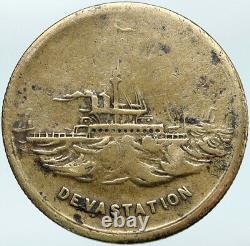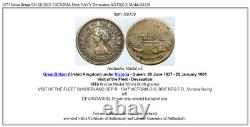1874 Great Britain UK QUEEN VICTORIA Fleet NAVY Devasation ANTIQUE Medal i88136




Item: i88136 Authentic Medal of. Queen: 20 June 1837 - 22 January 1901 Visit of the Fleet - Devasation 1874 Bronze Medal 30mm (9.08 grams) VISIT OF THE FLEET SUNDERLAND SEP R..
Was the first of two. Was built at a time in which steam power was well-established among the world's larger naval powers. The presence of masts also prohibited the use of gun turrets since the rigging would obstruct their arc of fire. Designed by Sir Edward J. Reed, represented a change from this pattern when she was built without masts and her primary armament, two turrets each with two 12-inch (305 mm) muzzle-loading guns, was placed on the top of the hull, allowing each turret a 280-degree arc of fire.She was 285 feet (87 m) long between perpendiculars, with a beam of 62 feet 3 inches (18.97 m), a mean draught of 26 feet 1.5 inches (7.96 m), and had a freeboard of only 4 feet 6 inches (1.37 m). She was armed with four RML 12 inch 25 ton guns, mounted in pairs in two turrets, protected by armour 12-14 inches (300-360 mm) thick. Her breastworks and hull were protected by 10-12 inches (250-300 mm) of armour, and she was also fitted with a 10-12-foot (3.0-3.7 m) spur bow. She was propelled by two four-bladed screws, 17 feet 6 inches (5.33 m) in diameter, each powered by two direct-acting trunk engines built by John Penn and Sons of Greenwich, providing a total of 5,600 horsepower (4,200 kW), with eight boilers, working at 30 pounds per square inch (210 kPa), giving a maximum speed of 12 knots (22 km/h; 14 mph).
Could carry 1,350 tons of coal, giving her a range of 3,550 nautical miles (6,570 km; 4,090 mi) at 12 knots or 5,570 nautical miles (10,320 km; 6,410 mi) at 10 knots (19 km/h; 12 mph). She also carried 30 tons of water, enough for three weeks, and 19 tons of provisions, six weeks supply for her crew of 329. Which capsized and sank on 6 September 1870 with the loss of 500 men, almost her entire crew, a special committee was appointed to examine the design of this type of vessel, and particularly the. The freeboard was increased to 10 feet 9 inches (3.28 m), and armour-plated bulkheads, between 4-6 inches (100-150 mm) thick provided additional protection to the magazines and engines. The 25-ton guns were replaced with RML 12 inch 35 ton guns. This additional weight increased her mean draught to 26 feet 8 inches (8.13 m). Sea trials were made in mid-1873 and generated an unusual amount of public interest; not just for the novelty of her appearance, but as the successor to the. In time trials she recorded a speed of 13.84 knots (25.63 km/h; 15.93 mph), the engines producing 6,637 horsepower (4,949 kW).Gunnery trials were made off the Isle of Wight, firing 700-pound (320 kg) Palliser shells. In a voyage from Plymouth to Castletownbere in southern Ireland, and from there she made two cruises out into the Atlantic. Apart from a tendency for her low forecastle to be swept by the sea, she performed slightly better than her companions in both pitch and roll. Was deployed to serve in the waters of the United Kingdom and the Mediterranean Sea.
In 1891, the 12-inch guns were replaced with 10-inch breech-loading guns and she was refitted with new triple-expansion steam engines. Commander Charles Henry Umfreville was appointed in command on 8 November 1898. She left the Mediterranean station headquarters at Malta, homebound, on 19 February 1902, and after a last visit to Gibraltar arrived in Plymouth 2 April.
She was paid off at Devonport 18 April, and proceeded to Portsmouth. She took part in the fleet review held at Spithead on 16 August 1902 for the coronation of King Edward VII. Later, she was refitted again and assigned to the First Reserve Fleet based in Scotland. Victoria (Alexandrina Victoria; 24 May 1819 - 22 January 1901) was Queen of the United Kingdom of Great Britain and Ireland from 20 June 1837 until her death. From 1 May 1876, she had the additional title of Empress of India.Victoria was the daughter of Prince Edward, Duke of Kent and Strathearn, the fourth son of King George III. Both the Duke of Kent and King George III died in 1820, and Victoria was raised under close supervision by her German-born mother Princess Victoria of Saxe-Coburg-Saalfeld. She inherited the throne aged 18, after her father's three elder brothers had all died, leaving no surviving legitimate children. The United Kingdom was already an established constitutional monarchy, in which the sovereign held relatively little direct political power.
Privately, Victoria attempted to influence government policy and ministerial appointments; publicly, she became a national icon who was identified with strict standards of personal morality. Victoria married her first cousin, Prince Albert of Saxe-Coburg and Gotha, in 1840. Their nine children married into royal and noble families across the continent, tying them together and earning her the sobriquet "the grandmother of Europe". After Albert's death in 1861, Victoria plunged into deep mourning and avoided public appearances. As a result of her seclusion, republicanism temporarily gained strength, but in the latter half of her reign her popularity recovered.
Her Golden and Diamond Jubilees were times of public celebration. Her reign of 63 years and seven months is known as the Victorian era. It was a period of industrial, cultural, political, scientific, and military change within the United Kingdom, and was marked by a great expansion of the British Empire.She was the last British monarch of the House of Hanover. Her son and successor, Edward VII, belonged to the House of Saxe-Coburg and Gotha, the line of his father. Great Britain, also known as Britain, is an island in the North Atlantic off the north-west coast of continental Europe.
With an area of 209,331 km. (80,823 sq mi), it is the largest island in Europe and the ninth-largest in the world.
In 2011 the island had a population of about 61 million people, making it the third-most populous island in the world, after Java in Indonesia and Honshu in Japan. The island is the largest in the British Isles archipelago, which also includes the island of Ireland to its west and over 1,000 smaller surrounding islands. The island is dominated by an oceanic climate with quite narrow temperature differences between seasons.
Politically, the island is part of the United Kingdom of Great Britain and Northern Ireland, constituting most of its territory: most of England, Scotland, and Wales are on the island, with their respective capital cities, London, Edinburgh, and Cardiff. The term Great Britain often extends to include surrounding islands that form part of England, Scotland, and Wales. A single Kingdom of Great Britain resulted from the Union of Scotland and England (which already comprised the present-day countries of England and Wales) in 1707.More than a hundred years before, in 1603, King James VI, King of Scots, had inherited the throne of England, but it was not until 1707 that the Parliaments of the two countries agreed to form a unified state. In 1801, Great Britain united with the neighboring Kingdom of Ireland, forming the United Kingdom of Great Britain and Ireland, which was renamed the United Kingdom of Great Britain and Northern Ireland after the Irish Free State seceded in 1922. World-renowned expert numismatist, enthusiast, author and dealer in authentic ancient Greek, ancient Roman, ancient Byzantine, world coins & more. Ilya Zlobin is an independent individual who has a passion for coin collecting, research and understanding the importance of the historical context and significance all coins and objects represent.
Send me a message about this and I can update your invoice should you want this method. Getting your order to you, quickly and securely is a top priority and is taken seriously here. Great care is taken in packaging and mailing every item securely and quickly.
What is a certificate of authenticity and what guarantees do you give that the item is authentic? You will be very happy with what you get with the COA; a professional presentation of the coin, with all of the relevant information and a picture of the coin you saw in the listing. Additionally, the coin is inside it's own protective coin flip (holder), with a 2x2 inch description of the coin matching the individual number on the COA. Whether your goal is to collect or give the item as a gift, coins presented like this could be more prized and valued higher than items that were not given such care and attention to. When should I leave feedback?
Please don't leave any negative feedbacks, as it happens sometimes that people rush to leave feedback before letting sufficient time for their order to arrive. The matter of fact is that any issues can be resolved, as reputation is most important to me. My goal is to provide superior products and quality of service. How and where do I learn more about collecting ancient coins?
Visit the Guide on How to Use My Store. For on an overview about using my store, with additional information and links to all other parts of my store which may include educational information on topics you are looking for.
